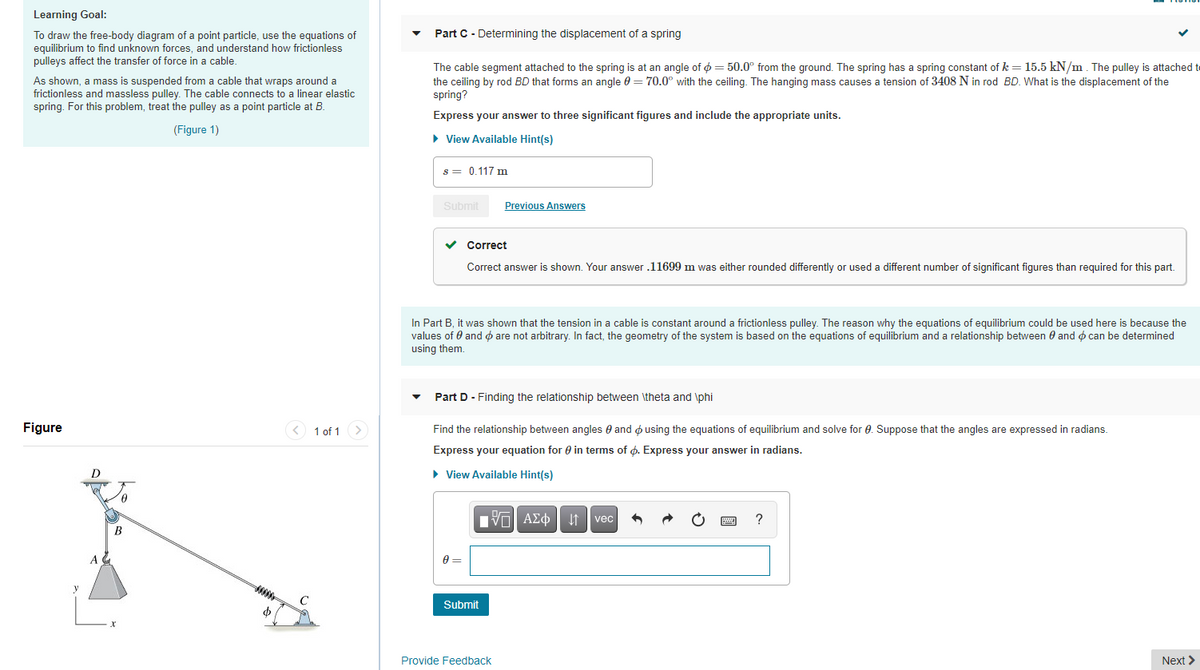Part C - Determining the displacement of a spring The cable segment attached to the spring is at an angle of o = 50.0° from the ground. The spring has a spring constant of k = 15.5 kN/m . The pulley is attac the ceiling by rod BD that forms an angle 0 = 70.0° with the ceiling. The hanging mass causes a tension of 3408 N in rod BD. What is the displacement of the spring? Express your answer to three significant figures and include the appropriate units. > View Available Hint(s) s = 0.117 m
Part C - Determining the displacement of a spring The cable segment attached to the spring is at an angle of o = 50.0° from the ground. The spring has a spring constant of k = 15.5 kN/m . The pulley is attac the ceiling by rod BD that forms an angle 0 = 70.0° with the ceiling. The hanging mass causes a tension of 3408 N in rod BD. What is the displacement of the spring? Express your answer to three significant figures and include the appropriate units. > View Available Hint(s) s = 0.117 m
Elements Of Electromagnetics
7th Edition
ISBN:9780190698614
Author:Sadiku, Matthew N. O.
Publisher:Sadiku, Matthew N. O.
ChapterMA: Math Assessment
Section: Chapter Questions
Problem 1.1MA
Related questions
Question
PART D

Transcribed Image Text:Learning Goal:
Part C - Determining the displacement of a spring
To draw the free-body diagram of a point particle, use the equations of
equilibrium to find unknown forces, and understand how frictionless
pulleys affect the transfer of force in a cable.
The cable segment attached to the spring is at an angle of o = 50.0° from the ground. The spring has a spring constant of k = 15.5 kN/m . The pulley is attached te
the ceiling by rod BD that forms an angle e = 70.0° with the ceiling. The hanging mass causes a tension of 3408 N in rod BD. What is the displacement of the
As shown, a mass is suspended from a cable that wraps around a
frictionless and massless pulley. The cable connects to a linear elastic
spring. For this problem, treat the pulley as a point particle at B.
spring?
Express your answer to three significant figures and include the appropriate units.
(Figure 1)
• View Available Hint(s)
s = 0.117 m
Submit
Previous Answers
Correct
Correct answer is shown. Your answer .11699 m was either rounded differently or used a different number of significant figures than required for this part.
In Part B, it was shown that the tension in a cable is constant around a frictionless pulley. The reason why the equations of equilibrium could be used here is because the
values of 0 and.
are not arbitrary. In fact, the geometry of the system is based on the equations of equilibrium and a relationship between e and ø can be determined
using them.
Part D - Finding the relationship between \theta and \phi
Figure
< 1 of 1
Find the relationship between angles e and o using the equations of equilibrium and solve for 0. Suppose that the angles are expressed in radians.
Express your equation for 0 in terms of o. Express your answer in radians.
D
• View Available Hint(s)
vec
В
A
Submit
Provide Feedback
Next >
Expert Solution
This question has been solved!
Explore an expertly crafted, step-by-step solution for a thorough understanding of key concepts.
This is a popular solution!
Trending now
This is a popular solution!
Step by step
Solved in 2 steps with 2 images

Knowledge Booster
Learn more about
Need a deep-dive on the concept behind this application? Look no further. Learn more about this topic, mechanical-engineering and related others by exploring similar questions and additional content below.Recommended textbooks for you

Elements Of Electromagnetics
Mechanical Engineering
ISBN:
9780190698614
Author:
Sadiku, Matthew N. O.
Publisher:
Oxford University Press

Mechanics of Materials (10th Edition)
Mechanical Engineering
ISBN:
9780134319650
Author:
Russell C. Hibbeler
Publisher:
PEARSON

Thermodynamics: An Engineering Approach
Mechanical Engineering
ISBN:
9781259822674
Author:
Yunus A. Cengel Dr., Michael A. Boles
Publisher:
McGraw-Hill Education

Elements Of Electromagnetics
Mechanical Engineering
ISBN:
9780190698614
Author:
Sadiku, Matthew N. O.
Publisher:
Oxford University Press

Mechanics of Materials (10th Edition)
Mechanical Engineering
ISBN:
9780134319650
Author:
Russell C. Hibbeler
Publisher:
PEARSON

Thermodynamics: An Engineering Approach
Mechanical Engineering
ISBN:
9781259822674
Author:
Yunus A. Cengel Dr., Michael A. Boles
Publisher:
McGraw-Hill Education

Control Systems Engineering
Mechanical Engineering
ISBN:
9781118170519
Author:
Norman S. Nise
Publisher:
WILEY

Mechanics of Materials (MindTap Course List)
Mechanical Engineering
ISBN:
9781337093347
Author:
Barry J. Goodno, James M. Gere
Publisher:
Cengage Learning

Engineering Mechanics: Statics
Mechanical Engineering
ISBN:
9781118807330
Author:
James L. Meriam, L. G. Kraige, J. N. Bolton
Publisher:
WILEY